Tag : Feminist Art
August 30, 2020 by Joan Roth
#Monumental Women: The First Statue of Real Women in Central Park
The Women’s Rights Pioneer Monument in Central Park’s Literary Walk, honoring Sojourner Truth, Elizabeth Cady Stanton & Susan B. Anthony was unveiled on Wednesday, August 26, 2020, at 7:45 AM.
“A few good women stepped forward to create history in the form of a powerful sculpture to affirm the leading role of women in our history, and its historical importance for New York City, and for the character of our nation,” said Manhattan Borough President, Gail Brewer. “When the struggle for this courageous sculpture began, the City of New York had only five specific sculptures on the subject of real women: Joan of Arc, Eleanor Roosevelt, Gertrude Stein, Harriet Tubman, and Golda Meir. None were in Central Park. Monumental Women banned together and set out to break the bronze ceiling, by honoring the three most important women who risked their lives for suffrage. The answer NO came in many forms: The Park is closed to new statues. Women do not want a statue they want a garden. If we say yes to this statue, we will have to say yes to any statue. You have to prove that each of these women had actually set foot into Central Park. Well, it took 70 years to get the vote and only 7 years to get a statue.”
 Close up view of the statue 100th anniversary of women getting the right to vote through the passage of the 19th Amendment.
Close up view of the statue 100th anniversary of women getting the right to vote through the passage of the 19th Amendment.
When Congress passed the 14th and 15th amendments, giving voting rights to African American men, Anthony and Stanton were angry and in turn, opposed the legislation because it did not include the right to vote for women. Their belief led them to split from other suffragists. They thought the amendments should also have given women the right to vote. They formed the National Woman Suffrage Association, to push for a constitutional amendment giving women the right to vote.
In 1872, Anthony was arrested for voting. She was tried and fined $100 for her crime. This made many people angry and brought national attention to the suffrage movement. In 1876, she led a protest at the 1876 Centennial of the nation’s independence. She gave a speech—“Declaration of Rights”—written by Stanton and another suffragist, Matilda Joslyn Gage.
“Men, their rights, and nothing more; women, their rights, and nothing less.”
Anthony died in 1906, 14 years before women were given the right to vote with the passage of the 19thAmendment in 1920.
Sojourner Truth was born into slavery on November 26, 1797, in Dutch-speaking Ulster County, New York, as “Belle” Baumfree. Bought and sold five times, she would become one of America’s leading abolitionist and women’s rights activist. Truth escaped to freedom in 1826. “After I left the house of bondage, I gave myself a new name, Sojourner Truth. When I left the house of bondage I left everything behind. I wasn’t going to keep nothing of Egypt on me, an’ so I went to the Lord an’ asked him to give me a new name. And he gave me Sojourner because I was to travel up and down the land showing the people their sins and bein’ a sign unto them. I told the Lord I wanted two names ’cause everybody else had two, and the Lord gave me Truth because I was to declare the truth to the people.”
>Elizabeth Cady Stanton was born on November 12, 1815, in Johnstown, New York. Daniel Cady, Stanton’s father, was a prominent Federalist attorney who served one term in the United States Congress (1814–1817) and then became both a circuit court judge and, in 1847, a New York Supreme Court justice. Judge Cady introduced his daughter to the law and, together with her brother-in-law, Edward Bayard, planted the early seeds that grew into her legal and social activism. Even as a young girl, she enjoyed reading her father’s law books and debating legal issues with his law clerks. It was this early exposure to law that, in part, caused Stanton to realize how disproportionately the law favored men over women, particularly married women. Her realization that married women had virtually no property, income, employment, or even custody rights over their own children, helped set her course toward changing these inequities.
As a young woman, Elizabeth Cady met and married Henry Brewster Stanton, with Elizabeth Cady requesting of the minister that the phrase “promise to obey” be removed from the wedding vows. She later wrote, “I obstinately refused to obey one with whom I supposed I was entering into an equal relation.” The couple had seven children. The couple first moved to Boston, Massachusetts, then to Seneca Falls New York.
Each of the women are holding something or carrying something. Each are equipped with an object that identifies them as a traditional statue. Elizabeth Cady Stanton, a writer and philosopher, has books by the foremothers of the women’s rights movement under her chair. Susan B, Anthony has her traveling bag, full of documents that she would bring to Stanton’s house to work on speeches with Stanton. In this case, they were fliers from lectures by Sojourner Truth, as well as from women’s conventions and conferences. Sojourner Truth has her characteristic shawl, and her cap, and carries her knitting, which she used as her own self-imaging and messaging. The women corresponded, met at women’s rights conferences, and shared the same stages.
It took 167 years to read the bronze ceiling, in order to make the Real Women Statue happen in Central Park.
Kathy Hochul, the Lieutenant Governor of the State of New York, said, “The journey for women’s rights does not end here in the park – it continues into the future. today is a historic day for women, who have not been properly represented in our nations and in our state’s history. Today all that changes.”
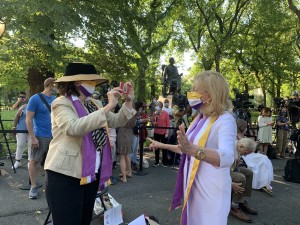
A descendant of Elizabeth Cady Stanton (wearing the hat) with Congresswoman Carolyn Maloney (the leader in Congress to pass the Equal Rights Amendment (ERA) to the Constitution)
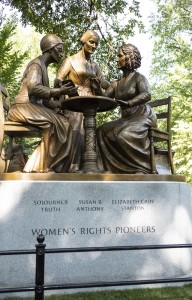
The Sculpture from Afar
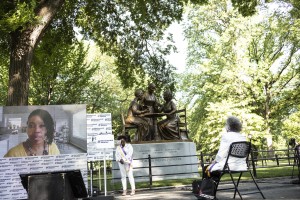
What does this monument mean to me? — It means hope. As a seventh-generation granddaughter of Sojourner Truth, this monument isn’t just here to remind us of our past. It’s not just here to remind us of the works that these three amazing women accomplished. It’s here to remind us of our future, to continue to stand up for what’s right, continue to stand up for what you believe in, continue to stand up for equality, for equal justice — to continue to stand up for what you know is true, what you know is good and what you know is right. It’s here to remind us to continue to stand, as the statue stands, so shall we! – Feminist Plumber, Judaline Cassidy
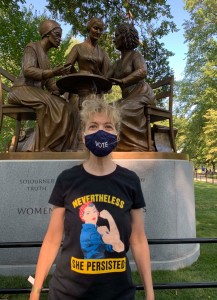
A wonderful outfit worn at the unveiling.
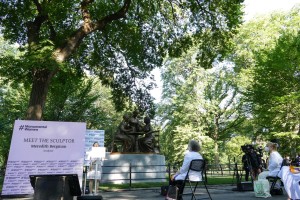
Sculptor Meredith Bergman points out some of the details we will see on the statue. “The first things people will notice,” she says, “is the intensity of the women talking, discussing. Passersby’s will try to figure out what they might be saying. Instead of wondering what they are saying, we hope viewers will be inspired to go read history to learn more.
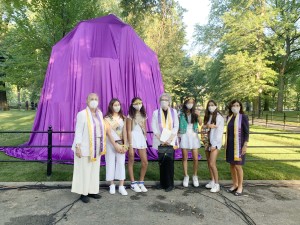
Left to right – Gale Brewer, Manhattan Borough President, girl scouts, Pam Elam, president of Monumental women, girl scouts, Lieutenant Governor Kathy Hochul
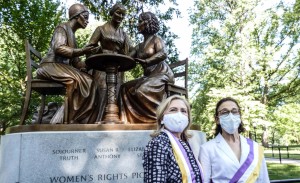
Hillary Clinton and the sculptor Meredith Bergman.
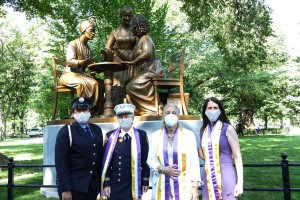
Left to right – Regina Wilson, Brenda Bergman (first female firefighter), Gale Brewer, and Manhattan Borough President, Heather Nestle
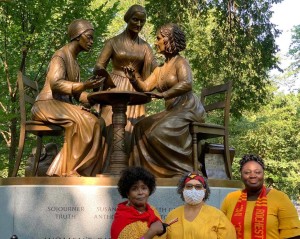
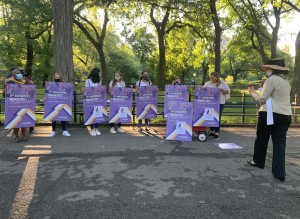
A descendant of Elizabeth Cady Stanton with the girl scouts. Each girl scout has a poster of the new stamp.
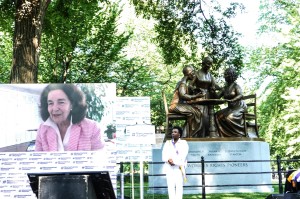
Pictured in the video presented at the unveiling is a descendant of Susan B. Anthony, who says, this statue represents generations of women who have fought for equal rights and are still fighting today. Most importantly we hope that younger women carry on our mission. Thank you so much for making this such a special day/Remember get out there and vote, as a human right.
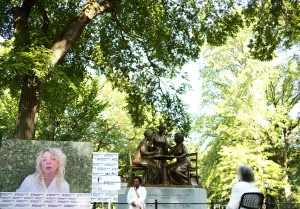
Pictured in the video presented at the unveiling is a descendant of Elizabeth Cady Stanton.
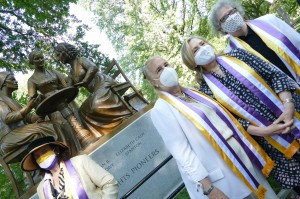
Pictured left to right: Great great-granddaughter of Elizabeth Cady Stanton, Coline Jenkins, Manhattan Borough President, Gale Brewer, former secretary of State Hillary Rodham Clinton, and Monumental Board President, Pam Elam.

Regina Wilson, FDNY Firefighter, singing “America the Beautiful.”

In the summer of 2016, Heather was on maternity leave when she read about the Central Park effort and vowed to be part of it. As president of New York Life Foundation, her company, agreed to support the project with a $500,000 challenge grant, to make the statue a reality. “This generous contribution was in no small part, due to the company’s relationship with Susan B. Anthony.” Nesle explains, “Anthony was one of our first female policy owners. Her father and brother-in-law were agents of the company, and she used the cash value of her policy to actually get the first women admitted to the University of Rochester.” A few months after she joined Monumental Women, Nettle would cast her vote for the first female candidate to run for president Hillary Rodham Clinton.
- No Comments
July 11, 2018 by Eleanor J. Bader
An Artist Who Welds Jewelry, Glass and Performance Together

As a little girl growing up on the outskirts of Durham, North Carolina, multidisciplinary artist Rachel Rader loved hearing—and eventually reading—all kinds of stories. She was especially fascinated by biblical narratives—she found the details of the flood myth and Noah’s creation of an ark particularly compelling. By the time she enrolled in Virginia Commonwealth University (VCU) in 2002, the Material Studies major decided to minor in Comparative Religion.
“I grew up going to a Conservative temple and always wondered what it meant that some people took biblical stories literally,” she begins. “Lately, I’ve been researching how myths repeat around the world, how they’re interpreted and presented by different cultures and religions, how they align and differ. That’s the inspiration behind my current effort, Ancient Truth Investigators, an ongoing, multi-dimensional art project that incorporates performance, sculpture, jewelry, and other materials.”
- No Comments
 Please wait...
Please wait...